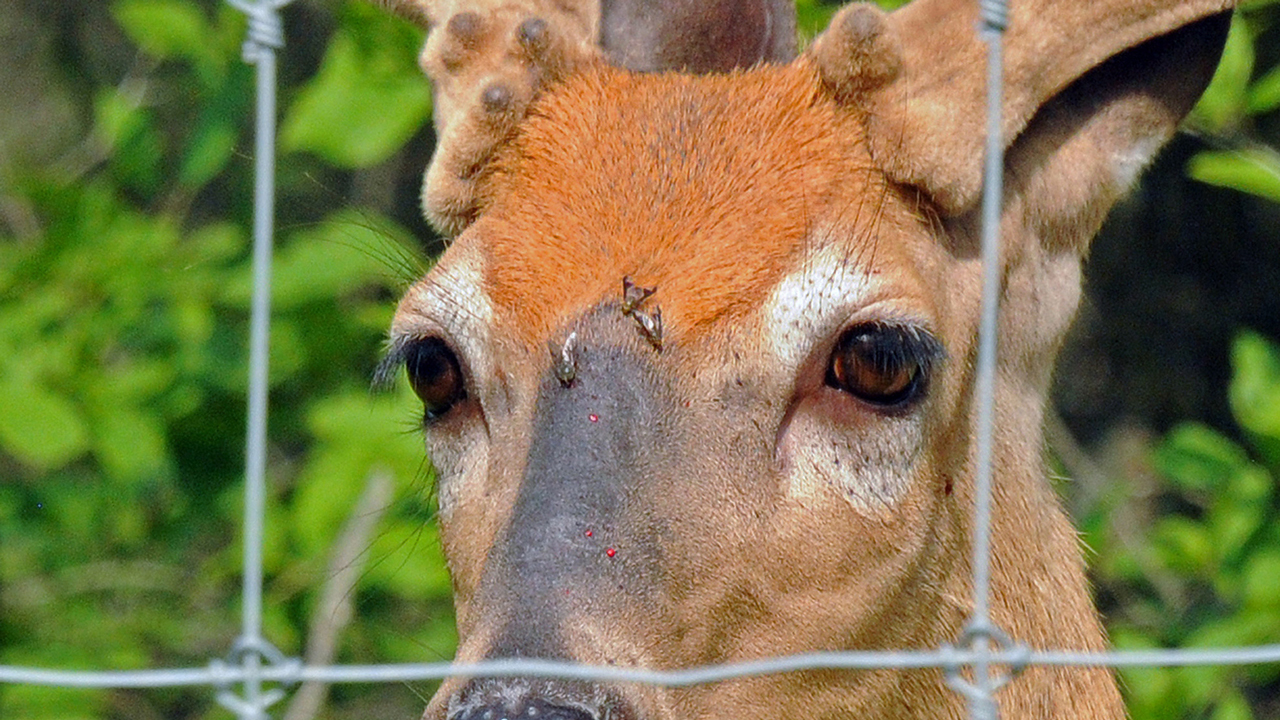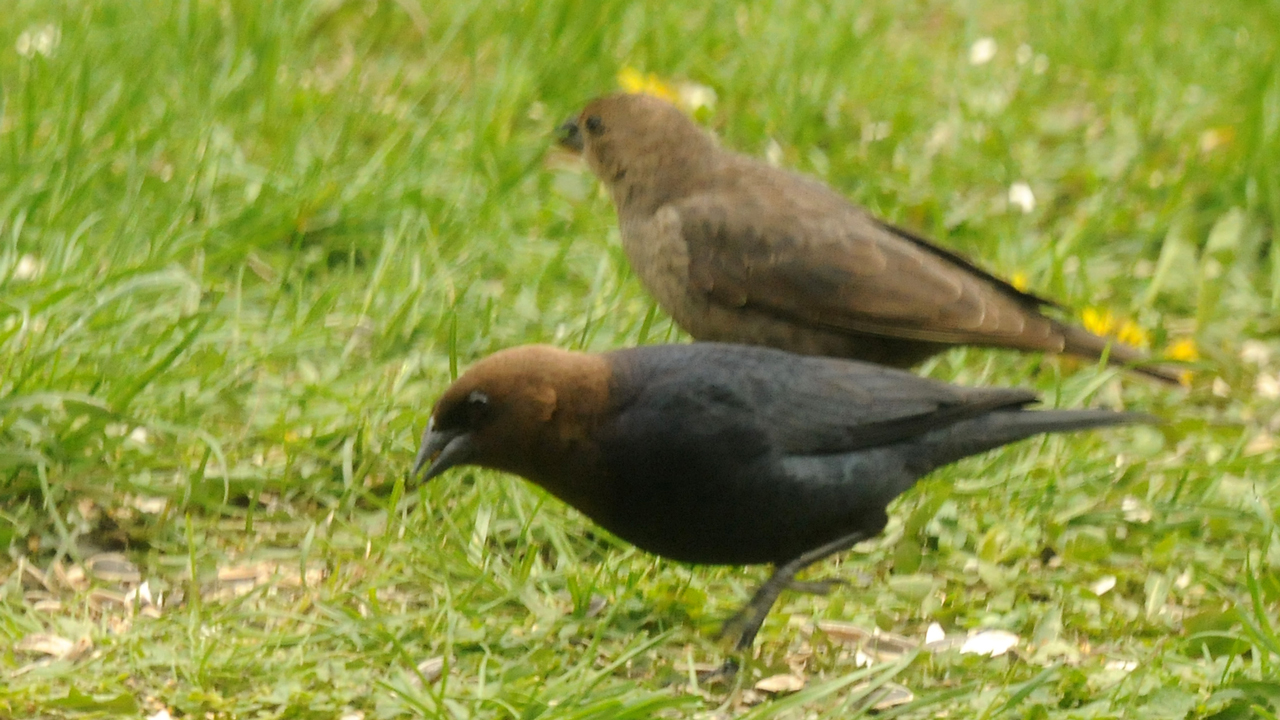If you had something bad to say about brown-headed cowbirds, my paternal grandmother welcomed you to sit beside her and cuss them as long as you liked.
Why? Because female cowbirds are awful mothers. They lay individual eggs in other birds’ nests, often after eating or discarding a legitimate egg already there. And then they fly off, abandoning their eggs so better mothers of different species can incubate and raise their babies. What parent practices such heartless, parasitic habits?

The whitetail’s summer coat is especially thin around their face and nose, making them easy targets for deerflies.
Prejudices that Granny taught me die hard, as the past 50 years attest. But Al Cornell of Hillsboro, Wisconsin, softened my dislike of cowbirds last week by posting photos on Facebook that showed them performing community service for white-tailed deer.
No lie. His pictures showed cowbirds sitting atop a couple of bucks, and snatching deerflies from between their eyes, and off their necks, backs and ears.
Cornell, a retired wildlife biologist who worked for the Wisconsin Department of Natural Resources, took the photos in early July at the Sandhill Wildlife Area near Babcock. He said he spotted about 20 deer that day, and half of them had cowbirds as personal attendants. In fact, some deer employed a pair of cowbirds, which perched anywhere from the deer’s head to its hips.
Cornell said deerflies were so thick that he wished to hire three cowbirds as his own personal attendants; one for each shoulder and another atop his head. Still, he’s unsure it would have paid off. Cowbirds can only eat so much, and deerflies seemed in infinite supply. “The deerflies were so abundant that I’m sure the cowbirds had full stomachs,” he said.
I recalled Cornell’s photos a couple of mornings later while running north of town. The early-morning sun was baking the back of my neck as I trotted west on a rural road separating two cornfields. I looked forward to reaching a shady lowland woods about a quarter-mile ahead, but then thought better of it.
Experience reminded me that deerflies love shadowy woodland edges, and rural roads provide long, shady stretches of ideal ambush sites. Minutes earlier I had run through a similar woods, and I could feel the itch worsening where a deerfly chewed my right shoulder.
Sure enough, as I reached the next woods, a deerfly scouting party flew past my arms and circled my head. I couldn’t evade or outrun them, so I flailed and swatted as they grazed my arms and buzzed the bald expanse my cap didn’t cover.
My right shoulder suffered another piercing bite about 100 yards later. Reaching up, I squashed the deerfly between a thumb and forefinger, glanced to confirm its identify, and flicked its corpse to the asphalt.
You bet I felt pleased.
And wishful. If only a squadron of cowbirds could escort me through the remaining woodlots between there and home. Sorry, Granny. When deerflies seek my blood, I’ll overlook the cowbirds’ character flaws.
But the cowbirds never came. They were probably still hanging out at my backyard feeders with the grackles, starlings and red-winged blackbirds.

Brown-headed cowbirds are native to North America, but fairly new to Wisconsin. They often ride atop cows and deer to feed on ticks and flying insects.
A week later I spotted a doe and fawn feeding along a road south of town. As I pulled alongside with my iPhone recording video, I spotted a big deerfly chewing on the doe’s nose. The ol’ girl seemed oblivious to it, much like the buck I spotted a couple of years ago as deerflies took turns chewing on his nose.
No cowbirds came to the rescue in any of my encounters. Maybe Cornell’s cowbirds were a unique flock that somehow learned to await prey atop deer, whose thin summer coats draw deerflies like porch lights attract June bugs. Cornell said he also photographed cowbirds atop deer at the Necedah National Wildlife Refuge in 2016, but those were the only sites where he’s witnessed deer and cowbird mutualism.
A good word, “mutualism.” Stan Temple, a retired University of Wisconsin-Madison bird professor, defines mutualism as individuals of different species working to benefit each other. Cowbirds eat deerflies off deer, the cleaner wrasse eats parasites and dead tissue off larger fish, and oxpeckers eat ticks and burrowing parasites from the backs of rhinos and zebras.
We see similar behaviors, of course, inside our state capitols and in Washington, D.C. Whenever pesky voters demand clean water or functioning wetlands, Sen. Oxpecker and Rep. Cowbird hop atop industrial developers and factory-farm owners to relieve their backsides of pesky hunter-conservationists and irksome regulations.
Meanwhile, back in Midwestern woodlands, Professor Temple notes that cowbirds weren’t always abundant east of the Mississippi. Until the 1800s cowbirds were more common on vast Western grasslands and the Great Plains, where they rode atop bison, elk, mule deer and even pronghorns. As the animals stirred up beetles, grasshoppers, horseflies, deerflies and other flying insects, cowbirds pecked and snatched breakfast, lunch, snacks and dinner.
“It’s kind of like hunters using flushing dogs to stir up grouse or pheasants,” Temple said.
As those large-bodied wildlife species declined across the West, settlers in the East and Midwest kept clearing fields and fragmenting woodlands for their crops and cattle. Cowbirds noticed the changes in wildlife and landscapes, and moved eastward to pursue new mutualistic relationships with beef cattle and dairy cows. Yes, they’re called “cowbirds” for a reason.
Unfortunately, woodland birds like the Kirtland warbler and black-capped vireo have no history with cowbirds, which left their small populations vulnerable to the cowbird’s parasitic nest behaviors. Every egg that cowbirds lay in those birds’ nests means one less Kirtland warbler or black-capped vireo.
People like me might forgive the cowbird those evils, assuming we’d suffer even worse deerfly onslaughts if not for the bird’s presence. But something tells me Granny never would. She saw only treachery in cowbirds, and they can’t eat enough deerflies to ever escape her scorn.

 By
By 



